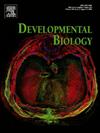Organizational principles of integumentary organs: Maximizing variations for effective adaptation
IF 2.5
3区 生物学
Q2 DEVELOPMENTAL BIOLOGY
引用次数: 0
Abstract
The integument serves as the interface between an organism and its environment. It primarily comprises ectoderm-derived epithelium and mesenchyme derived from various embryonic sources. These integumentary organs serve as a barrier defining the physiological boundary between the internal and exterior environments and fulfill diverse functions. How does the integument generate such a large diversity? Here, we attempt to decipher the organizational principles. We focus on amniotes and use appendage follicles as the primary examples. The integument begins as a simple planar sheet of coupled epithelial and mesenchymal cells, then becomes more complex through the following patterning processes. 1) De novo Turing periodic patterning process: This process converts the integument into multiple skin appendage units. 2) Adaptive patterning process: Dermal muscle, blood vessels, adipose tissue, and other components are assembled and organized around appendage follicles when present. 3) Cyclic renewal: Skin appendage follicles contain stem cells and their niches, enabling physiological molting and regeneration in the adult animal. 4) Spatial variations: Multiple appendage units allow modulation of shape, size, keratin types, and color patterns of feathers and hairs across the animal's surface. 5) Temporal phenotypic plasticity: Cyclic renewal permits temporal transition of appendage phenotypes, i.e. regulatory patterning or integumentary metamorphosis, throughout an animal's lifetime. The diversities in (4) and (5) can be generated epigenetically within the same animal. Over the evolutionary timescale, different species can modulate the number, size, and distributions of existing ectodermal organs in the context of micro-evolution, allowing effective adaptation to new climates as seen in the variation of hair length among mammals. Novel ectodermal organs can also emerge in the context of macro-evolution, enabling animals to explore new ecological niches, as seen in the emergence of feathers on dinosaurs. These principles demonstrate how multi-scale organ adaption in the amniotes can maximize diverse and flexible integumentary organ phenotypes, producing a vast repertoire for natural selection and thereby providing effective adaptation and evolutionary advantages.

外皮器官的组织原则:最大化变异以有效适应。
被膜是生物体与其环境之间的界面。它主要包括来自不同胚胎来源的外胚层上皮和间充质。这些外皮器官是界定内外环境生理界限的屏障,具有多种功能。被皮是如何产生如此巨大的多样性的?在这里,我们试图破译组织原则。我们将重点放在羊膜上,并以附属物卵泡为主要例子。被膜最初是上皮细胞和间充质细胞偶联的简单平面薄片,然后通过以下模式过程变得更加复杂。1) De novo Turing周期图图化过程:该过程将被膜转化为多个皮肤附属物单元。2)适应性模式过程:当附属物毛囊存在时,真皮肌肉、血管、脂肪组织和其他成分在附属物毛囊周围组装和组织。3)循环更新:皮肤附属物毛囊中含有干细胞及其壁龛,可实现成年动物的生理蜕皮和再生。4)空间变化:多个附属物单位可以调节动物表面羽毛和毛发的形状、大小、角蛋白类型和颜色模式。5)时间表型可塑性:循环更新允许附属物表型的时间过渡,即调节模式或被皮变形,贯穿动物的一生。(4)和(5)中的多样性可以在同一动物内通过表观遗传产生。在进化的时间尺度上,不同的物种可以在微观进化的背景下调节现有外胚层器官的数量、大小和分布,从而有效地适应新的气候,就像哺乳动物毛发长度的变化一样。新的外胚层器官也可以在宏观进化的背景下出现,使动物能够探索新的生态位,就像恐龙羽毛的出现一样。这些原理证明了羊膜动物的多尺度器官适应如何能够最大限度地多样化和灵活的被膜器官表型,为自然选择提供了大量的曲目,从而提供了有效的适应和进化优势。
本文章由计算机程序翻译,如有差异,请以英文原文为准。
求助全文
约1分钟内获得全文
求助全文
来源期刊

Developmental biology
生物-发育生物学
CiteScore
5.30
自引率
3.70%
发文量
182
审稿时长
1.5 months
期刊介绍:
Developmental Biology (DB) publishes original research on mechanisms of development, differentiation, and growth in animals and plants at the molecular, cellular, genetic and evolutionary levels. Areas of particular emphasis include transcriptional control mechanisms, embryonic patterning, cell-cell interactions, growth factors and signal transduction, and regulatory hierarchies in developing plants and animals.
 求助内容:
求助内容: 应助结果提醒方式:
应助结果提醒方式:


